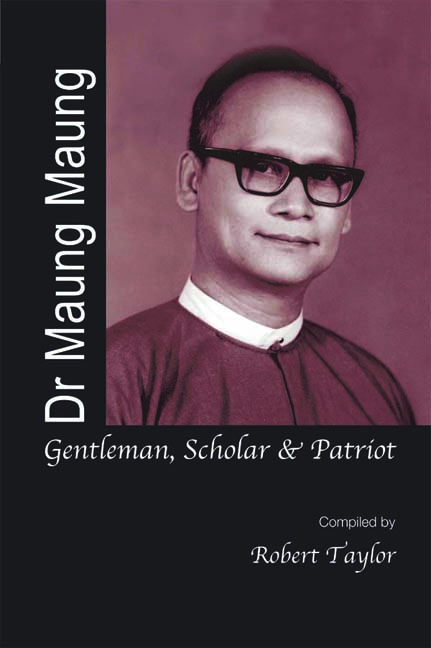Book contents
- Frontmatter
- Epigraph
- Contents
- Preface
- Acknowledgements
- Section I Dr Maung Maung: The Life of a Patriot
- Section II Dr Maung Maung's Approach to Life
- Section III Dr Maung Maung and Biography
- Section IV Dr Maung Maung and Travel
- Section V Dr Maung Maung and the Tatmadaw
- Section VI Dr Maung Maung and the Constitutions of Myanmar
- Section VII Dr Maung Maung and the Presidency
- Bibliography of Dr Maung Maung's Writings
- Index
- The Editor
Section VI - Dr Maung Maung and the Constitutions of Myanmar
Published online by Cambridge University Press: 21 October 2015
- Frontmatter
- Epigraph
- Contents
- Preface
- Acknowledgements
- Section I Dr Maung Maung: The Life of a Patriot
- Section II Dr Maung Maung's Approach to Life
- Section III Dr Maung Maung and Biography
- Section IV Dr Maung Maung and Travel
- Section V Dr Maung Maung and the Tatmadaw
- Section VI Dr Maung Maung and the Constitutions of Myanmar
- Section VII Dr Maung Maung and the Presidency
- Bibliography of Dr Maung Maung's Writings
- Index
- The Editor
Summary
If Dr Maung Maung's patriotism drew him toward the tatmadaw in which he had briefly served and many of whose top officers were close friends of his, his journalistic avocation drew him naturally to write about the politicians, judges, and journalists who were prominent in the 1950s, again many personal friends. But his professional career as a lawyer drew him naturally to write about the constitutions of Myanmar with which he was engaged. The 1947 constitution, under which he lived and worked during the period when he wrote the overwhelming bulk of his English-language writings, in particular, was a subject about which he knew perhaps more than anyone at that time. His writings were widely read by foreigners as their key historical guide to understanding constitutional developments in Myanmar at least up to the military take over in March 1962. His writings on the constitution were so influential not only because they were erudite but also they drew a very broad picture of the role and life of the constitution, seeing it as a living set of aspirations as well as a clear guidelines for the rules and procedures with which the government, and the wider state, were to conduct their affairs.
In the days soon after the height of Burma's post-independence civil war, Myanmar's socialist politicians sought an ideological guide that took them away from the accusation that they were little different from the Communists who they were battling. They also sought to reassure both Western governments that they were not Marxists, then a particularly unacceptable word in the midst of the Cold War, and also to convince more conservative elements in Myanmar's own society that they were not taking the country down a path which was antithetical to Buddhism, the faith of the overwhelming majority of the country. However, the 1947 constitution contained a number of leftist, if not explicitly socialist, ambitious that the government sought to achieve while maintaining its very shallow political support. This posed a serious presentational and policy issue for a government whose major domestic political opposition was on the radical left of the political spectrum.
- Type
- Chapter
- Information
- Dr Maung MaungGentleman, Scholar, Patriot, pp. 439 - 522Publisher: ISEAS–Yusof Ishak InstitutePrint publication year: 2008

